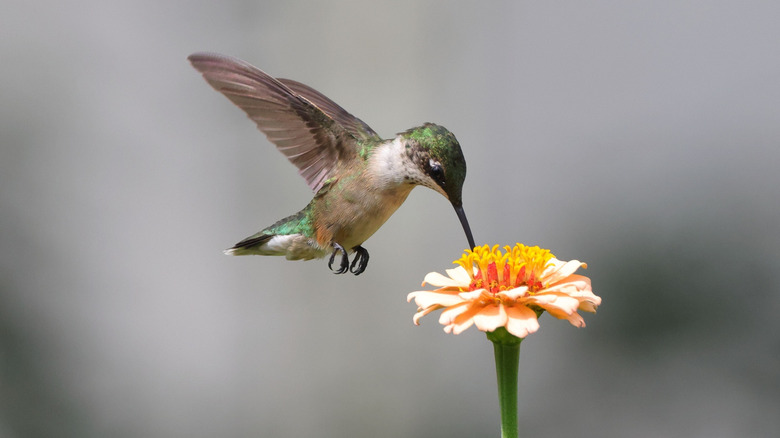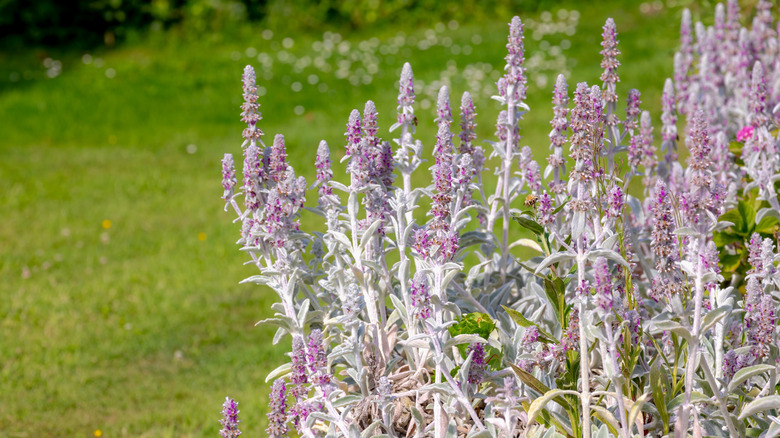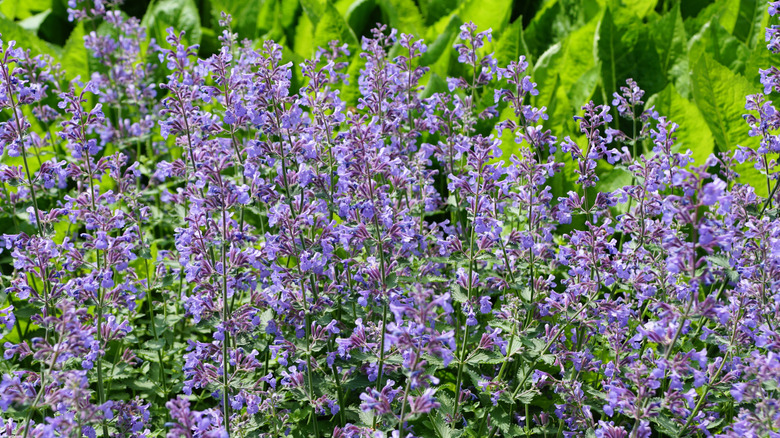The Beautiful Garden Solution Hummingbirds Can't Get Enough Of
Nothing perks up a day in the garden more than the arrival of the fast-moving little hummingbird zipping around blooms and nectar feeders. If you want to attract more of the small pollinators to your yard the natural way, try planting a crop of lamb's ear (Stachys byzantina) or catmint (Nepeta racemosa).
These versatile plants, both members of the mint (Lamiaceae) family, are hummingbird favorites. Lamb's ear is known for its fuzzy grayish-green or silver leaves. The first part of its name, Stachys, is the Greek word for "ear of corn," which is exactly what its tubular lavender blooms look like. The soft leaves of lamb's ear also make good padding for a hummingbird's nest. Hummingbird's nests are no bigger than a golf ball, so they're hard to find. If you want some tips for spotting a hummingbird's nest in the garden, try looking for them near the forks of thin branches.
Hummingbirds love feeding from the lamb's ear tubular blooms in the spring and summer and aren't particular about cultivars. They like many varieties of lamb's ear, including S. coccinea, or red-flowered lamb's ear. In general, hummingbirds like most members of the mint family, and that includes catmint and their nectar-rich blooms. The pretty blooms of both catmint and lamb's ear will keep your yard looking great and hummingbirds well fed and happy.
Tips on growing lamb's ear to attract hummingbirds
Lamb's ear is easy to grow. It thrives in USDA Plant Hardiness Zones 4 through 9, and will tolerate a wide variety of soils. It prefers either full sunlight or partial shade, but it doesn't like to be overwatered and it could languish in humid climates. Red-flowered lamb's ear grows in similar conditions, but it's slightly less tolerant of cold, and does best in zones 6 through 9. In warmer climates, it'll offer pretty red blooms from March through October.
When you're thinking about how to care for lamb's ear plants, plan on dividing them every few years so that they don't get too crowded. Lamb's ear is a fairly tough plant. It's resistant to drought and deer will typically avoid it. Lamb's ear is a hummingbird favorite, but it can also be a great ground cover if you've got bare spots in your flowerbeds that have become a breeding ground for weeds.
You'll know your lamb's ear is thriving when it begins to grow its fuzzy leaves in rosette-like patterns. Shortly after, it'll grow tall stalks with lavender flowers in the spring, and then it'll die back. In warmer climates, lamb's ear can be an evergreen. In colder ones, the leaves will die back in the late fall, and sprout again come spring. Take note, however, that lamb's ear can be an aggressive grower in the right conditions.
How to grow catmint to attract hummingbirds
Like lamb's ear, catmint is also a no-fuss herbaceous perennial. Hummingbirds love its flowers in part because of its long blooming season. Catmint won't only attract hummingbirds to your garden, it's also known to repel certain annoying pests like aphids and squash bugs. It's a win-win for everyone, as you can feed the hummingbirds, repel pests, and add catmint's pretty, sweet-smelling blue and purple flowers to the garden.
Catmint is easy to grow, and it's even more cold tolerant than lamb's ear, surviving winters up to zone 3. Catmint — not to be confused with catnip, a different member of the mint family — prefers full sunlight, not shade and will thrive in loam, rocky, shallow, or sandy soils. Keep in mind that catmint doesn't like fertilizer, so skip feeding these plants. Over-fertilized plants might not bloom, or worse, they might grow weakened stalks that topple over.
If you're wondering about how to propagate the catmint plant, you can do so by dividing the plant or by using cuttings. For the cutting method, just cut a 6-inch stalk, typically below a set of leaves in the spring or summer when the plant is at its healthiest. Plant the cutting in a small pot or even a container of water and expose it to plenty of sunshine. You'll be able to transfer it from your container or pot to your flower bed in a couple of weeks. Like lamb's ear, catmint can grow aggressively, so plant strategically and enjoy your new hummingbird friends.


